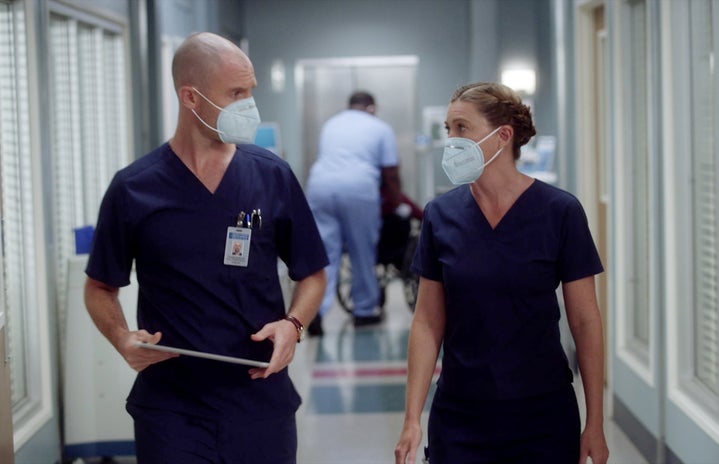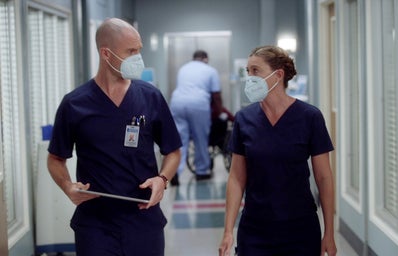You may have heard of shows like ER, The Good Doctor, or Scrubs; medical dramas that are far from realistic. But there is one medical show that focuses more on what life should be. That show is Grey’s Anatomy.
Grey’s Anatomy premiered on ABC in 2005, but it was not just another medical drama. The show follows surgical interns, residents, and attendings through nail-biting surgeries, relationship woes, and, most importantly, tear-jerking storylines. Grey’s Anatomy is known for always making the impossible happen, attaching the audience to those who get shot, almost drown, and survive a plane crash, to name a few – and so far, we’re only talking about the doctors, never mind the patients who endure about everything one could find on WebMD. But through the years, the series has brought light to many unexplored subjects that demonstrate how the world should be. Being the longest-running, scripted primetime television series, the show’s cast has always been erratically changing, but one thing remains the same after three-hundred (and counting) episodes: the diversity of the cast deserves applause. And in continuation of the progress, the series never confused the cast members to be filling quotas. Instead, Grey’s Anatomy displayed all skin colors, genders, races, and sexualities at Grey-Sloan Memorial Hospital onto our television screens, changing the game for Hollywood and our world as we know it.
Many rely on television as an escape from the world around them. Little do many consumers realize, television has become a platform to bring light to crucial topics that need to be discussed. And Grey’s Anatomy is a prime example of facing deep issues and obstacles that many long for in today’s society. It is safe to say that Grey’s Anatomy has lasted seventeen seasons, not because of the ever-changing cast and love stories beyond compare, but because of their efforts to tackle hot-button issues such as feminism, gun control, domestic abuse, and the coronavirus pandemic, for example. This series may fit the mold of a primetime fictional show but it is refreshing to see an inclusive storyline of what we struggle with, confide with, and advocate for.
Yes, of course, the doctors save lives in the show, but a majority of those cutting during exhausting surgeries are women. Feminism has always played a cutting-edge role in the show and maybe it’s because the writers and producers are mainly female (including 30 female directors), but either way, the message became clear: all sorts of women, no matter their background, can hold positions of leadership. Miranda Bailey is a woman of color and the Chief of Surgery. Maggie Pierce is a woman of color and the head of the cardio department. Callie Torres is a woman of color, head of the orthopedic department, and is bisexual. Arizona Robbins is a lesbian, and head of fetal medicine. Meredith Grey is head of general surgery and a single mother of three kids. And Amelia Sheppard is head of the neuro department and a (now clean) addict. But the writers did not just give the women listed these positions of power. Throughout the series, viewers get a look into the struggle women face in the inequality of demands versus the male doctors. And holding positions of power is not where feminism stops. The show displays same-sex relationships between women (and men) as normal (as it should be!) while still showing the discrimination that these couples face. For example, Callie Torres’ family would not accept her when she came out and refused to come to her wedding. The show paints the LGBTQ community a picture, in support, of what life should be, celebrating a same-sex marriage before it was even legalized. Another clear example of feminism was brought to light in season twelve. When Meredith Grey was promoted to the head of general surgery, she demanded equal pay after conferring with her male friend and saw how much more he made than what she was being offered. Although displayed through fictional characters, Grey’s Anatomy provides real-world examples, as well as, how all women should be treated within the workplace.
Two other nationwide problems that Greys has raised awareness on are gun control and domestic abuse. In season six (2010), the hospital endured a mass shooting. The shooter was portrayed by an older white male who was coping with his wife’s surgery-gone-wrong. Besides the fact that it was a terrifying two-part season finale to watch, the writers were attempting to bring awareness and fear towards gun violence without normalizing the issue. To speak about gun control, the writers included lines like “I can’t believe how easy it was for me to go to the store and just buy a gun”, and “it was so effortless to buy bullets as well, but I didn’t have enough pockets to carry them all”. These troubling lines addressed the change that needed to happen in 2010 to end these horrific events, but no one listened.
Another hard-to-watch episode was in season fifteen, titled Silent Through All These Years. Main character Jo Wilson has just admitted to being a victim of domestic abuse when a rape victim comes into the hospital. Jo helps her through the process. Many medical shows have attempted to bring awareness to abuse, but Grey’s Anatomy was commended by their fans for the accurate depiction of administering a rape kit. Grey’s, unlike other television shows, understands the topics before covering them. For this episode, all cast members took a field trip to UCLA’s Rape Treatment Center to learn how to, error-freely covers this topic. Pictured are women lining the halls, supporting the victim and making her feel safe.
These examples are not supposed to make you scared of the series. There is a reason why so many episodes are hard to watch. It is because Grey’s Anatomy displays the hardships of what our lives entail that many are scared to speak openly about. And now, at its seventeenth season, cultural critic Ani Bundel, compares to previous seasons the show “ripped from the headlines” strategy of storytelling. COVID-19 was making an appearance this season no matter what.
Since we are currently living in a pandemic, it is only fitting that a medical show would follow the year that 2020 was. But, not surprisingly, Grey’s Anatomy stuck true to themselves and was willing to tackle the day-to-day life of a doctor during a pandemic. Grey’s newest competitor, The Good Doctor, began its most recent season in the pandemic, but the following episode then contained the message, “For purposes of the show, The Good Doctor will now act as though we are past COVID-19 and are back to normal”. You could argue that The Good Doctor is wanting to provide its viewers a form of escapism from the world we are all living in. But Grey’s Anatomy is using this time to spread the messages of utmost importance right now before it is too late: wear a mask, social distance, COVID-19 is real, support the health care workers, and black lives matter.
The show dives into the frustration between doctors and patients, doctors and doctors, and everyone against the world. The show is not finding some amazing cure to save all patients. Instead, we are seeing many never recover, or the struggle of contracting the virus from main character Meredith Grey. Other critics have agreed that the current season of Grey’s Anatomy is thriving. Showrunner, Krista Vernoff explained the production’s point of view as having an obligation to display the reality that non-healthcare workers aren’t witnessing. Yes, this season is not all sunshine and rainbows. But it demonstrates the impact of our current situation, reminding the audience how many have died and how doctors truly feel: helpless.
A few episodes into the covid season, the Black Lives Matter protests and demand for equality is brought to light; injured protesters come into the ER, many doctors are protesting, and a black doctor is pulled over by the police, displaying the uneasy interaction many encounters. This season seems like it is a documentary of experiences from the last year because of the accuracy portrayed. Many underprivileged communities are even spoken about, demanding health care for everyone. One of the doctors is stuck at home with her newborn and other children and we see her swirling into craziness from being stuck. It might be fictional, but this season, especially, hits home for anyone watching, even the covid deniers. One male comes into the ER, continuously being told to put on his mask, and when asked to take a COVID test, he refuses and begins complaining about conspiracy theories. This factor made the show feel a tad more real.
With a score of 3 out of 10 when ranking Grey’s Anatomy’s realism compared to other medical shows, the grade is simply comparing the atrocious display of medical inaccuracies. But aren’t these surgical mistakes and doctor “sexcapades” the way a drama intrigues the viewer? There is a reason why the highest-rated accurate show, Scrubs, is no longer on television. Maybe Grey’s Anatomy took the spotlight because of their totally unrealistic portrayal of hospital life with the mix of advocating for what our world should be.
Grey’s Anatomy is exceptional at courageously covering the truth behind what needs to be fixed in our world and, during this season, has begun displaying the medical community’s truth. One thing is certain: Grey’s Anatomy aims to have a real-world effect. Even though you might be sitting through hours and hours’ worth of surgeries, thinking you could be a doctor tomorrow, the progression of the show itself is worth the watch (and the steamy romances too! But that’s another article).

